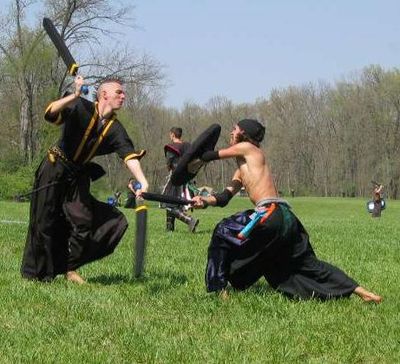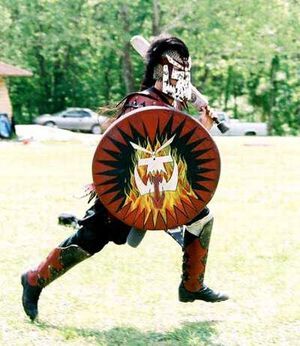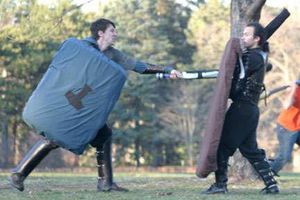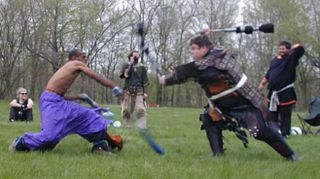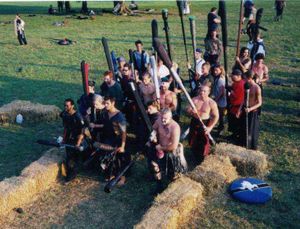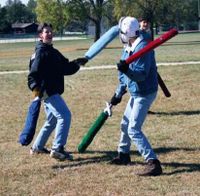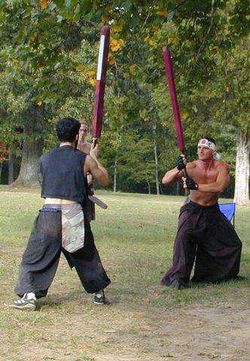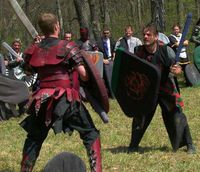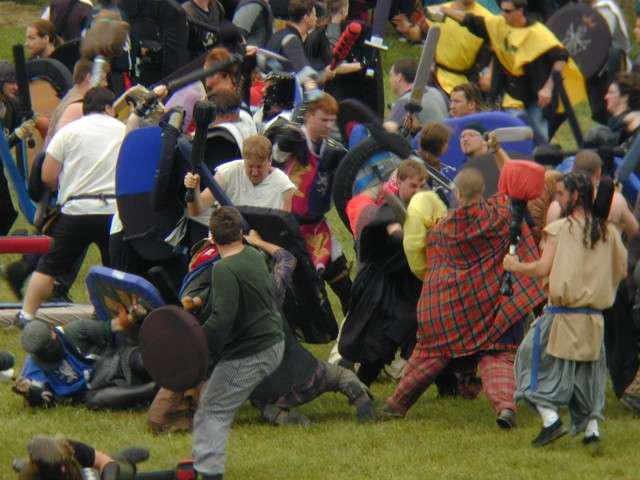Start Fighting
From BelegarthWiki
How to Fight
Here is some advice and some basic techniques to try when you start fighting. Keep in mind there are a hundred veterans who could potentially tell you a hundred different things about what they think is the best way to fight. In time you will develop your own unique fighting style that incorporates the techniques that work best for you. This manual aims to merely demonstrate some basic techniques and open your mind to what lies beyond them. Finding what works best for you is yours to pursue.
What equipment should I start with?
Many veterans recommend starting with a short to medium size sword (18-24” blade) and a medium round shield (28” diameter). This combination is a great way to learn stance, footwork, mobility, basic swings, and active blocking. Despite this, materials for shields cost more than any other kind of equipment ($20-40 for materials), and is a more significant investment. If you are going to an established group, you can probably borrow most any weapon combination and get a feel for what you like, then build or buy what works for you. On a national level, sword and shield is the most common fighting style, and it is a good idea to know how to fight both with and against that style. With it being so common, there is often a demand for good ranged weapon fighters who use polearms, great swords, or archery. Most of the fighting tips presented henceforth stem from fighting with sword and board (shield) or could also be applied to florentine (two-weapon) fighting. The following two styles are what will really start you on your way to understanding fluid blocking and attacking, particularly in one-on-one fighting.
Basic Stance
Basic defensive sword and board fighting stance: If you are a right handed fighter, place your left foot forward towards your opponent and your right foot back perpendicular to your lead foot. (If you are left handed reverse it). When you look down you should be able to picture a capital ‘L’ running along the inside of your feet. Bend your knees slightly and let more weight rest on your back leg than your front. In some martial arts this is referred to as a ‘back fighting stance’. Now it is time to raise your guard. Put your shield in front of your body with the top edge covering your shield shoulder. Your torso should actually be facing somewhat sideways making it harder for your opponent to reach it. Put your sword arm up and slightly back behind your shield. Leave your sword arm behind your shield unless you are swinging. For a more offensive fighting stance, reverse the defensive stance. Lead with your weapon foot and angle your body so that your weapon arm is towards your opponent. This gives you a longer strike range.
Active Blocking
It is extremely important to be an active blocker. Your shield and weapons by themselves will not protect you. You need to move them! Using a medium size shield, you can operate it in two primary ways. The first is ‘punching’ attacks away by pushing your inside fist in the direction of an incoming blow. Keeping your inside shield edge pointed slightly towards your opponent will allow you to actively block wrap shots and flails. The other is sliding or rolling your shield across in front of your body side to side or up and down to intercept blows. This makes it harder to swing around your own shield, but covers your body better. How you block and how close you keep your shield to your body is primarily a personal preference. Each method works better at blocking different shots. Experiment with both types of blocking and use whichever works better for you. With a shield, the general idea is always putting the face or edge of your shield between the striking surface of your opponent’s weapon and your body. It is also often necessary to block shots with your weapon. When blocking with a weapon it is ok to ‘punch’ block with your hand on the weapon, however it is preferable to aim to intercept the blow with the lowest part of the blade or haft of your weapon, so as to spare your hands repeated blows. Weapon blocking is a vital skill to incorporate into florentine and great sword fighting.
Gripping Your Weapon
A very common grip method among veterans is called a ‘fishing’ grip. It involves making a fist around your weapon handle then placing your thumb up along the handle. When you swing your reach comes from your arm, your snap and strike motion comes from your wrist, and your placement and guidance comes from your thumb. This thumb-up style is only recommended for one handed swung weapons and can jam your thumb if you receive a hard strike into your weapon so be careful! Use a regular fist grip when gripping a great sword or spear. The theory is that you can snap your shots faster using more wrist and less arm (which keeps you less exposed) and with more precision with the fishing grip. With practice this technique will help you develop faster combos and more precise swings. Snap shots and wrist flicks are very precise, but can end up landing light blows. If you are having problems with delivering light blows, you may want to swing more from your shoulder and elbow, and less from your wrist.Basic Swings
A few simple swings:
- Low outside to your opponent’s leg.
- Mid outside to your opponents shield side.
- Mid inside to inside opponents’ shield. (Often called a ‘wrap’)
- Drop shot to opponents’ shoulder. (Gain control before attempting, practice slowly before using on the field, and avoid headshots!)
- Counter-swing to opponent’s weapon arm.
Counterattacking
Counterattacking means you wait for your opponent to swing, then block and swing back at whatever they leave open, often their weapon arm. You can practice this by being aware of your opponents’ shoulders with your peripheral vision. When their weapon arm shoulder moves, you chop straight down and across sweeping the line in which your opponent’s weapon arm is extending from while blocking their shot. With practice you can consistently take your opponents’ weapon arm making them much easier to kill. This is a good technique to perfect for people who aren’t exceptionally quick offensively.
Combination Attacks
Combinations are vital to developing advanced fighting. Your opponent can often anticipate where your first shot is going, even if you are fast, however a second or third swing is much less predictable. When going on the offensive, practice throwing multiple swings in quick succession. Easy examples are high/low or side/side. Slap your opponents shield then quickly chop off their leg. Or take a quick tap to their shield side getting them to move it over, then swing inside to their arm or body. With practice, you will develop the ability to attack using combinations while blocking incoming combinations yourself. As shots are exchanged between opponents, openings (places not covered by the opponents’ shield) will come and go. In time you will attune yourself to when these opportunities arise and place a quick shot there before they have a chance to block again.
Footwork
When fighting with a round shield using a back fighting stance, practice moving your feet to dodge rather than blocking low with your shield. When you drop your shield, you open up your body, exposing yourself to potential death. Also, it is slower to move your shield down to block your lower leg than it is to sweep your foot back. This is why you keep more weight on your back leg and keep your front foot on its ball and ready to move. When you see a leg shot swooping in, merely drag your foot back for a quick second. A good exercise to practice with a partner is this: Face off sword & board. Have your opponent swing slowly at your lower leg. When their swing comes in, sweep your leg back, and counter-swing, striking off their weapon arm. Have them increase their speed gradually pushing you to move your feet and counter-swing faster. You can practice florentine footwork by not allowing yourself to weapon block. Always dodge, back-peddle, and keep moving around your opponent, striking as they leave openings. For great sword and pole arm fighting, learning to back peddle quickly and strike low very rapidly is a very handy skill. Your aim is to keep the advantage of your weapon range and take off your opponents’ legs in the process.
Head Shots
Shots to the head with melee (handheld) weapons are illegal. You should never try to hit your opponent in the head, but sometimes it will happen accidentally. When you do receive a head shot, merely say to your opponent ‘head’ and keep on fighting. You can take certain measures to keep yourself from getting hit in the head however. It is not all your opponent's fault. Do not duck into swings or put your head behind your shield! If you do this, the head shot is your fault. Keep your back straight and stay slightly leaned away from your opponent. When you swing low, do not dive or sweep your body and head down with your swing. When you do this, you are prone to getting hit!Fighting Against Spears & Great Swords
When possible, pole weapons are best countered with missile weapons (javelins and archery). If you do not have missile support, you may have to rush the polearm yourself. When you must face off with a polearm or great sword alone and you have florentine or a shield, the best way to deal with them is single them out and rush up on them quickly. In order to do this, position yourself just outside their attack range. Lure them to swing at you then dodge it, block it, or shove their weapon out of the way while quickly running towards them. Keep your shield or weapon pinned against their weapon as you approach them to prevent them from striking at you again. Once in close, you have the advantage and you can swing for their arms and body. Always beware however, many good spearmen carry a sidearm and will let you rush their polearm just to strike you while your guard is low pinning down their weapon. It takes practice to become good at, but the main thing when you are new is to not be intimidated by large weapons.
When You’re New
If you are a new member in an established group, seek to follow and assist a veteran fighter on the field. If you stay close to them, you will help them be more effective, and you will be more likely to live. When they engage someone, try to attack the person they are engaging from the side or back. Fighting two on one, flanking, and backstabbing will make you more effective when you start. You do not have to be the best one on one fighter in order to have a good field presence. You should also try keeping your shots mid to low level until you gain enough control to fight higher. Legs are easier to hit than a body covered by a shield, and even if you die in the process of taking the leg of a veteran fighter, you have seriously impaired their mobility for the game, potentially halting further damage they could have caused your team. You should try your best to score a hit on your opponent, even if they kill you in the process. In time you will learn to block or dodge the shots that are killing you. In short: Double team, attack on the flank, aim low, and follow the guidance of veteran fighters.
Class 2 Weapons
Class 2 Weapons, also referred to on the field as ‘red’ weapons, have some special abilities in combat that all fighters need to be aware of. When a red weapon is swung with two hands and strikes an armored area, it goes straight through the armor. When you are delivering a red swing (a two handed swing with a class 2 weapon), you should loudly call “Red!” so the person receiving the blow knows what sort of damage to take. Also, when swung with two hands, red weapons have the ability to break a shield. When a red weapon user swings with two hands, strikes a shield, and calls “Red!,” it is then the responsibility of the shield user to pronounce whether the shot was solid enough or not. If they believe it was light, they should say “light.” If they believe their shield received a solid enough strike, they would then say “one” for the first hit. After a second red strike the shield wielder should say “two” and drop their shield, as it has been broken. If they are unable to drop their shield quickly, a third strike counts as going through to the arm even if it strikes the shield (because the shield is broken), and a fourth strike would proceed to the body. Light hits and scrapes to shields from red weapons do not have to be taken because in the concern of realism, it would take multiple solid swings from a large weapon to render a typical shield useless. If you are wielding a red weapon and a shield user does not think your shot was solid enough, simply swing harder, or aim for the edge of the shield. The weight and padding of both the shield and red sword will have a big impact on whether or not a red hit feels sufficient. Different people will have different standards for what they qualify as a hit worthy of breaking their shield. It should be noted however, that a direct red hit to an armored area should be taken with the same standards as that of a strike to an unarmored area. The shot does not have to be excessively hard.
How to Learn and Keep Growing
If you are a new fighter in an established group, seek out a veteran fighter who is willing to be a mentor to you. Ask them for tips on sparring, techniques, and maintaining good field awareness. You can grow a lot merely by sparring with veteran fighters and following them closely on the field. If you are starting your own group away from an established group, do all you can to go to national events. At national events there is a wealth of veterans, many of which will give you pointers if you just ask. When there is downtime or an extended water break, seek out veteran fighters to spar with. Do not be bashful if you are inexperienced. Ask them what they observe about your strengths, weaknesses, and what you can improve on. Also do not be discouraged if it seems like some veterans do not have time for you. There are many different people at events and some will be occupied with running the event, taking trials and tests, or spending time with their unit that they only have the opportunity to do at events. Observing and fighting with veterans will go a long way in helping your grow.There is a lot of useful information available to a new fighter however, in order to grow as a fighter you will need to seek out more help. There are two great ways to get better as a fighter. The first is to attend lots of events with experienced fighters in attendance. Seek them out on the field and engage them. You will probably die often, but if you learn how they killed you it is worth it. Most fighters are very friendly and would be happy to show you how they killed you if you ask. This leads into the second best way to become a better fighter. Sparring better fighters will help you develop attacks and defenses that you would not otherwise learn. If you have experienced fighters in your home realm talk with them about how to get better but if you do not have anyone significantly better than yourself at home you should take full advantage of experienced fighters at events you attend by asking them to spar with you!
Field Mindset
Your mindset on the field is one of your most important assets to both enjoying the game, and performing well. First and foremost remember this is a game. Belegarth MCS is an organization aimed at having fun by engaging in fantasy and history oriented battle scenarios. Our style of game is intense and full contact. Arguments and injuries can happen, but your attitude can prevent them from happening. So when you are on the field; keep your cool, follow the rules, and aim to have a good time.
